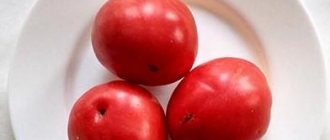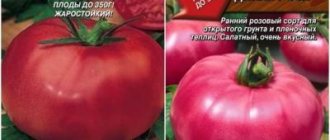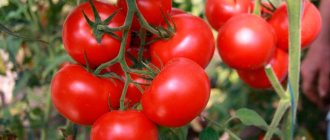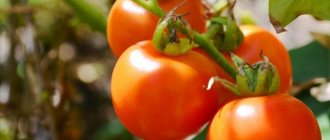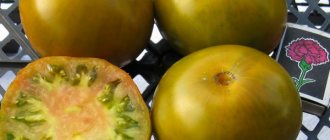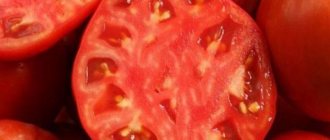Strong, tall tomato bushes with orange fruits that look like exotic fruits will delight any gardener. In addition, yellow and orange tomatoes are hypoallergenic. Orange tomatoes do not contain lycopene, they are suitable for dietary and baby food.
| Height | Landing location | Ripening time | Fruit color | Fruit size | Origin | Fruit shape |
| Tall | Greenhouse, Open ground | Mid-season | Orange | Large | Variety | Round |
Description and characteristics of the variety
Not only the Orange tomato and the Donetsk Orange tomato are found in Russian gardens; foreign guests, the Pear Orange tomato Pera Naranja and the Sweet Ozark Zarka tomato, have also found fans.
The bushes are indeterminate, height 1.5-1.9 meters. Mid-season tomatoes. They ripen en masse at the end of July and August. Plants are stocky, internodes are of medium length. The leaves are tomato, large, dark green. There is a pronounced articulation on the stalk. The root system develops vertically.
The fruits have an increased content of beta-carotene.
The inflorescences are simple, the flowers are ordinary, non-double. The first brush is laid after 8-9 sheets, the next after 3 sheets. 3-6 round tomatoes are tied on a brush. In green fruits the ribbing is pronounced; on ripe fruits it is almost absent. The fruits are large, at technical ripeness, light green with a yellow tint. As they ripen, they turn yellow and gradually darken.
Ripe tomatoes have a uniformly colored yellow-orange or deep orange skin. The fruits are multi-chambered, with fleshy juicy pulp. The color of the pulp matches the color of the skin. The core is without a hard “pit”.
Tomato variety Orange, video
If you grew Orange tomatoes, please write whether you liked them or not. What was the yield and taste of the fruits like under your climatic conditions? How do you rate the disease resistance of this variety? Briefly describe the advantages and disadvantages of this tomato in your opinion. If possible, attach to the comment a photo of the entire bush as a whole or individual fruits that you grew. Thank you!
Your reviews of the Orange tomato and additions to the description will help many gardeners evaluate this variety more objectively and decide whether it is worth planting or not.
This is a natural variety of tomato. Therefore, we recommend taking seeds from a ripe fruit and using them for planting in subsequent seasons.
Features of cultivation and storage
Tomato loves loamy soils and prefers open sunny areas. To increase productivity, the plant is formed into 2 stems and periodically fed. The variety has the ability to set fruit in the most unfavorable conditions. In the southern regions it has time to ripen in open ground; for the middle zone it is recommended to plant it in greenhouses.
In case of abundant harvests, the stems and fruit clusters are tied separately at the ripening stage.
The purpose of the variety is salad, so the tomatoes are unsuitable for storage. The delicate skin and pulp of ripe fruits quickly lose their taste and soften. Ripe tomatoes must be processed immediately after picking.
Breeding characteristics of the variety
The tomato, thanks to domestic breeders, appeared on household plots and small fields of small farms in 2000.
Since the crop was originally bred for private gardeners, it is not customary to grow such tomatoes on an industrial scale. According to the ripening period, the vegetable is mid-season; the fruits fully ripen in 95-110 days from the moment the first shoots appear. More about the plant in detail.
Fruit:
- the color is bright yellow, sometimes with an orange tint;
- average weight 200-300 g, maximum – 400 g;
- round, may have slight ribbing;
- the pulp with a sweetish taste is at the same time dense, tender, juicy;
Orange Tomato Seeds
- very few seeds;
- the yield is good, but the information from official sources does not coincide slightly with the reviews of gardeners. In the first case, from 1 m² they promise up to 5.2 kg, gardeners receive up to 10 kg of vegetables;
- in terms of storage and transportation, the score is 3 points: they quickly soften and disappear.
Advice. Since it is a salad variety, tomatoes are good fresh; small tomatoes are suitable for canning.
Reviews from gardeners
Most summer residents have long been familiar with Orange tomatoes and actively grow them. They highlight the unique taste of the fruit and high yield. The variety also makes it possible for people who are allergic to red tomatoes to consume these vegetables. Reviews about Orange tomatoes are mostly good.
Tatyana, Volgograd: “I’ve been growing Orange for three years in a row. The description of the variety and the photo on the package with seeds convinced me that this species is worthy of attention. I liked the tomatoes for their unsurpassed taste. Before that, I really liked the Pink Giant, but after making a salad with Orange tomatoes, my whole family stopped recognizing other tomatoes. The grandchildren ask me to make them “red” juice, they really liked it. I grow a lot of tomatoes: enough for food, for sale, and for canning. I recommend this variety to everyone."
Evgeniy, Tula: “I learned about Orange from a neighbor in the country. He once treated me to a gathering, after which I immediately asked him for seeds. I don’t let anyone near my tomatoes; I grow them myself. When my wife saw yellow tomatoes in the garden, she laughed that I was growing oranges. I liked the fruits for their taste, aroma, structure and large size. I couldn’t pull my wife by the ears. I wouldn’t say that the yield is greater than that of other varieties, but not less. I’m happy and will continue to grow.”
Svetlana, Ivanovo: “We have always grown tomatoes in the country. With the advent of my granddaughter, they began to plant yellow varieties, since she has diathesis and is allergic to everything red, and the child loves tomatoes and picks them straight from the garden - you can’t keep track of them. The whole family really liked the Orange variety. These tomatoes do not cause any reaction other than positive in my granddaughter, even if she drinks the juice. Overall I can say that the variety is very good. This is a worthy replacement for red tomatoes. They don’t require any special care.”
Pest and disease control
In order for Orange tomatoes to be less susceptible to diseases typical of nightshade crops, it is necessary to carry out a number of preventive measures during the seedling phase. Until the tomatoes started to bear fruit.
Various types of rot:
These diseases can be avoided if you properly care for your tomatoes: water them on time, feed them, and create the necessary temperature conditions.
But to prevent late blight, it is advisable to spray with fungicidal preparations.
- Orange tomato bushes are sprayed for the first time a week after planting in the ground.
- The last spraying is carried out at least 3 weeks before harvesting the fruits.
In the fight against the most terrible enemy of tomatoes - the Colorado potato beetle - the old ancestral method will help - picking by hand. If there are still a lot of beetles, you will have to use chemicals from the store. Whiteflies, slugs and other evil spirits - chemicals fight them better.
Growing tomatoes
The Orange variety is not a hybrid, so you can independently collect seed for planting in subsequent seasons (the grains are stored for no more than 3 years).
Growing seedlings
It is recommended to plant the seeds in the second half of March, otherwise there is a high probability that the sprouts will become very elongated. It is not difficult to select empty grains - the seed is soaked in salted water and the specimens that have settled to the bottom are left for planting. Standard stages of growing seedlings:
- Before planting, seeds are germinated by wrapping them in wet material and placing them in a warm place.
- A special box is filled with soil mixture, shallow grooves are made into which the grains are placed and lightly sprinkled with earth.
- The container is covered with glass/film and placed in a warm room.
As soon as the shoots appear, the protective covering is removed and the box is placed in a well-lit place.
Transplantation to a permanent place
You can replant seedlings approximately 20 cm high that have grown 6-8 leaves.
Approximate arrangement of holes in the bed: 40 cm step in a row and 50 cm – row spacing. Seedlings are first planted in furrows so that the soil retains moisture longer and the plants take root faster.
The best predecessors for Orange tomatoes are beans, peas, corn, green manure (winter wheat, rye). It is undesirable to be near potatoes.
Bush care
Basic care measures:
- Watering. Water as needed, not allowing the soil to dry out, no more than twice a week. To water one bush, 3-4 liters of water are consumed. Watering should be carried out exclusively at the root;
- Feeding. Fertilizers are applied three times per season. The first fertilizing is carried out 10 days after transplantation, using manure (1 kg per liter of water) or ready-made fertilizers. The second time is 10 days after the first brush begins to bloom. Manure is also added with the addition of a tablespoon of “Solution” and 3 grams of potassium permanganate and copper sulfate (per bucket of water). Each bush will need 2 liters of the resulting mixture;
The last feeding is carried out during the harvest period with a similar composition, but in a larger volume - 2.5 liters per bush.
- The soil needs regular weeding and loosening. In the intervals between waterings, the soil next to the seedlings is weeded and loosened. With the help of these procedures, the root system is saturated with oxygen, and the possible development of certain diseases is also prevented;
- When forming bushes, remove the stepsons and lower large leaves. The procedure is carried out in sunny, windless weather, this will allow the wounds to heal faster and avoid infection by pathogenic bacteria.
Advantages and disadvantages
Advantages of the Orange tomato variety:
- stable high yields;
- citrus appearance and large fruit;
- aroma and sugar content of fruits;
- resistance to late blight;
- take up little space;
- medicinal characteristics (tomatoes normalize the functioning of the gastrointestinal tract, compensate for the lack of keratin, and are suitable for dietary nutrition).
Cons of Orange:
- not suitable for storage;
- low level of transportability;
- requirements for care: garter, pinching.
Orange tomatoes have proven themselves to be productive, tasty and beautiful plants. Subject to the rules of agricultural technology, 3-4 kg of tomatoes are harvested from each bush. Their taste is rated as excellent.
Disadvantages include the need for plant formation and the variety’s poor resistance to disease.
